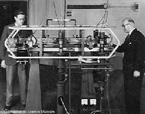![]() Atomic Clock
Atomic Clock
Atomic time from an atomic clock is the most exact accurate time correct to 1 second in 1 million years.
|
|
| Galleon | Atomic Clock | Time servers | Computer Time | CCTV | Time and attendance | Digital Wall Clocks | Time server products | Contact | |
|
Galleon
|
Atomic Clocks | |
 First atomic clock 1955
|
Atomic clocks achieve accurate time because they are controlled by radio transmitters which themselves receive their time signals from amazingly accurate timepieces, Caesium Atomic Clocks. These clocks are based upon the characteristics of the Caesium 133 atom, whose single electron is known to vibrate at a standard 9,162,613,770 times a second. The Caesium Atomic Clocks have an accuracy of one second in one million years!
First accurate caesium atomic clock The National Physics Laboratory developed the first accurate caesium atomic clock in 1955, which led to the internationally agreed definition of the second being based on atomic time. The second is defined as 9,192,631,770 periods of the caesium-133 atom, and is currently realised at NPL to an accuracy of one second in 15 million years. Scientists are currently working on technology to increase this accuracy to 1 second in 10 billion years. The controlling radio signal for the National Physical Laboratory's clock is transmitted on the MSF 60kHz signal via the transmitter at Rugby, operated by British Telecom International. This should have a range of some 1,500 km or 937.5 miles. All of the British Isles are of course within this radius. The National Physical Laboratory's role as keeper of the national time standards is to ensure that the uk time-scale agrees with co-ordinated universal time (utc) to the highest levels of accuracy and to make that time available across the uk. as an example, the msf (msf being the three-letter call sign to identify the source of the signal) radio broadcast provides the time signal for, electronic share trading, the clocks at most railway stations and for bt's speaking clock. A radio system is available in North America and has been set up and operated by NIST - the National Institute of Standards and Technology, located in Fort Collins, Colorado. NIST operates radio station WWVB, which is the station that transmits the time codes. WWVB has high transmitter power (50,000 watts), a very efficient antenna and an extremely low frequency (60,000 Hz). For comparison, a typical AM radio station broadcasts at a frequency of 1,000,000 Hz. The combination of high power and low frequency gives the radio waves from WWVB a lot of bounce, and this single station can therefore cover the entire continental United States plus much of Canada and Central America.. The time codes are sent from WWVB using one of the simplest systems possible, and at a very low data rate of one bit per second. The 60,000 Hz signal is always transmitted, but every second it is significantly reduced in power for a period of 0.2, 0.5 or 0.8 seconds: · 0.2 seconds of reduced power means a binary zero · 0.5 seconds of reduced power is a binary one. · 0.8 seconds of reduced power is a separator. The time code is sent in BCD (Binary Coded Decimal) and indicates minutes, hours, day of the year and what year it is, along with information about daylight savings time and leap years. The time is transmitted using 53 bits and 7 separators, and therefore takes 60 seconds to transmit. A clock or watch can contain an extremely small and relatively simple antenna and receiver to decode the information in the signal and set the clock's time accurately. All that you have to do is set the time zone, and the atomic clock will display the correct time. The controlling radio signal for the German clock is transmitted via long wave from the DCF 77kHz transmitter at Mainflinger, near Dieburg, some 25 km south east of Frankfurt - the transmitter of German National Time Standards. It is similar in operation to the Rugby transmitter, however there are two antennas (radio masts) so the signal can be maintained at all times. Long wave is the preferred radio frequency for transmitting time code binary signals as it performs most consistently. This is because the longwave signal carrying the time code to your timepiece travels in two ways; directly and indirectly. Between 700 km (437.5 miles) to 900 km (562.5 miles) of each transmitter the carrier wave can travel directly to the timepiece. All of the British Isles are within the radius of this transmitter. A large part of the European Union area is covered by this transmitter facilitating reception for those who travel widely in Europe. Although the German clock is set on Central European Time - one hour ahead of U.K. time, following an inter-governmental decision, from the 22nd October, 1995, U.K. time will always be 1 hour less than European Time with both the U.K. and mainland Europe advancing and retarding clocks at the same "time". For all of the Galleon time server products visit our time servers page with links to the Galleon network time server solutions. |
|
|
For more information about Galleon Systems and products Contact Galleon . |
Telephone Galleon: 0121 608 7230 | International:+44 121 608 7230
|
|
Home | Correct time for computers | CCTV | OEM Modules | Time and Attendance | Product Finder | FAQ's | Contact | Galsys.co.uk || |
| | | |
© Galleon2003